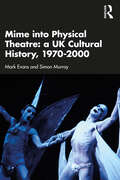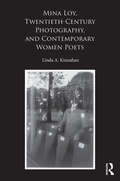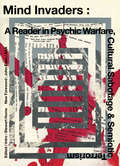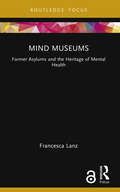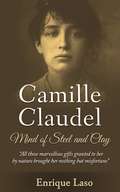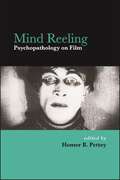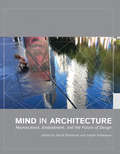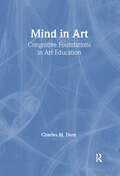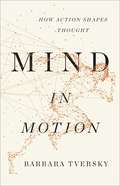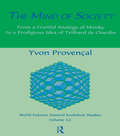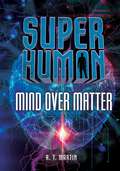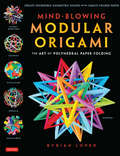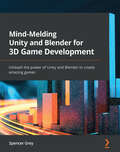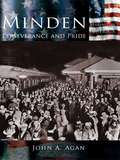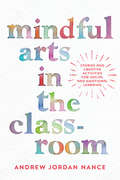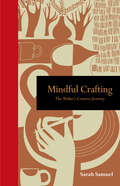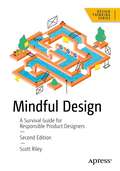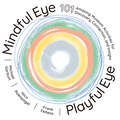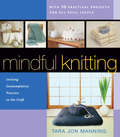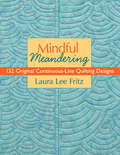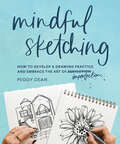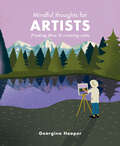- Table View
- List View
Mime into Physical Theatre: A UK Cultural History 1970–2000
by Simon Murray Mark EvansThis is the first book to investigate the social, political, cultural, artistic and economic forces which created conditions for the rise, success and decline of mime and physical theatre in the United Kingdom, from the 1970s to 2000. Unpicking the various routes through which mime and physical theatre emerged into wider prominence, this book outlines key thematic strands within this history of practice. The book blends historical description and refl ective analysis. It aims to juxtapose the various histories at play within this field, giving critical attention to the voices of the artists, funders and venue managers who were there at the time, particularly recognising the diversity of practitioners and the network of relationships that supported their work. Drawing upon over 40 original interviews, including, amongst others: Joseph Seelig, Helen Lannaghan, Steven Berkoff, Julian Chagrin, Annabel Arden, Nola Rae, Denise Wong, David Glass, Justin Case and Toby Sedgwick, the book offers unique testimonies and memories from key figures active during these three decades. This wide-ranging account of the history, social context, key moments and practical methods gives an unparalleled chronicle of one of the UK’s most vital and pioneering forms of theatre. From undergraduate students to established scholars, this is a comprehensive account for anyone studying contemporary theatre, theatre history, mime, physical theatre and the structures that support the performing arts in the United Kingdom.
Mina Loy, Twentieth-Century Photography, and Contemporary Women Poets
by Linda A. KinnahanIn Mina Loy, Twentieth-Century Photography, and Contemporary Women Poets, Linda A. Kinnahan explores the making of Mina Loy’s late modernist poetics in relation to photography’s ascendance, by the mid-twentieth century, as a distinctively modern force shaping representation and perception. As photography develops over the course of the century as an art form, social tool, and cultural force, Loy’s relationship to a range of photographic cultures emerging in the first half of the twentieth century suggests how we might understand not only the intriguing work of this poet, but also the shaping impact of photography and new technologies of vision upon modernist poetics. Framing Loy’s encounters with photography through intersections of portraiture, Surrealism, fashion, documentary, and photojournalism, Kinnahan draws correspondences between Loy’s late poetry and visual discourses of the body, urban poverty, and war, discerning how a visual rhetoric of gender often underlies these mappings and connections. In her final chapter, Kinnahan examines two contemporary poets who directly engage the camera’s modern impact –Kathleen Fraser and Caroline Bergvall – to explore the questions posed in their work about the particular relation of the camera, the photographic image, and the construction of gender in the late twentieth century.
Mind Invaders
by Stewart Home"The only movement to work consistently towards the death of history since the disbanding of the Situationist International has been the Global Neoist Network.Since 1979, Neoism has been defending the revolutionary gains made by the Situationists and Fluxus. The Neoists are the only group to have brought about the conjunction of nihilism and historical consciousness -- the two elements essential for the destruction of the old order, the order of history." You can never quite be sure to what degree Stewart Home, (or the Neoists from whom he noisily split, but under who's banner he long continued to write / agitate), is/was taking the p*ss. Decades of provocation, parody, backhanded agitation, ideological feuding, art, anti art, ideological feuding as both art and anti art, all of it written up, reported upon, exaggerated, added to, invented, and thrown into the face of late 20th / 21st century culture /subculture, first as polemic, eventually as farce. Mind Invaders was first published in 1997, culled from a panopoly of underported , unregarded, barely noticed sources : obscure zines, half finished manifesto's , loosely formed political strands starting to coalesce in shaded corners of the early web. Through force of will and a desire to exist, it pulled together a ramschackle, but somehow cohesive collection of currents that run deep through the post Situationist, anti-art, anti-trot, anti-spectacle European underground, tracing a definable lineage back from Dada > Bauhaus > Lettristes, through to the mail art movement of the 60's, loosely tied to Fluxus, and by it's very nature, a scattered, interconnected avant garde network, attempting to subvert the art-industrial complex by circumventing it, undermining commercial straitjackets by ignoring them. Techno paganism and Avant-bardism, 3 sided football, Five Year Plans for establishing community-based Autonomous space programmes around the world, psychogeographers planning to levitate . the Corn Exchange in Hulme...and most prominently,"The Luther Blissett Project, launched in Bologna, Summer '94, by an international gang of revolutionaries, mail artists, poets, performers, underground 'zines, cybernauts and squatters, collectively casting a long, long shadow.
Mind Museums: Former Asylums and the Heritage of Mental Health (Museums in Focus)
by Francesca LanzMind Museums offer a fresh perspective on the heritage of mental health,bringing museums into sharp focus. Drawing on interdisciplinary approachesfrom architecture, museum and exhibition design, and heritage and museumstudies, it examines former psychiatric asylums that have been converted intomuseums.The book presents a comprehensive investigation of mind museums, thefirst of its kind in Europe, and explores their potential in raising awarenessand dismantling the stigma surrounding mental health. Through an indepthexamination of selected European examples, Lanz describes whatmind museums are and how they came to be. The innovative visitor studiescarried out at the Museo di Storia della Psichiatria in Reggio Emilia, whichare presented here, explore people’s encounters with mind museums andreveal the profound impact of such experiences. By uncovering the power ofthese heritage sites in facilitating discussions on mental health, civility, andcare, Lanz provides new insights into the emotive capacity of the museumand visitors’ reflexivity at place-based memory sites.Mind Museums will be of great interest to scholars and postgraduatelevelstudents engaged in the study of museums, heritage, exhibitiondesign, architecture, and mental health. It should also be of interest toheritage professionals, particularly those working in mind museums andother similar sites, such as prison museums and sites of conscience.
Mind Of Steel And Clay: Camille Claudel
by Enrique Laso Emma May PriceMind of Steel and Clay: Camille Claudel is a diary. Through the guilt-ridden words of Edouard Faret, Director of the psychiatric hospital of Montdevergues, we are drawn into to the life of an exceptional woman, Camille Claudel.In the 19th century, Camille was an unrivalled sculptress and both the student and lover of Auguste Rodin. She wanted to make a name for herself in a world of men, to achieve the fame and prestige that her work deserved, but this never came to pass.In 1913, after the death of her adored father, her family committed her by force to an asylum. There she would stay, locked up against her will for 30 years until her death, despite the doctors and others who argued in defence of her sanity.Mind of Steel and Clay: Camille Claudel tells the tragic tale of an extraordinary woman, an artistic genius whose fate was sealed with misfortune.For the first time ever, the dark, unknown years of Camille's confinement, an era shrouded in mystery, are revealed and explored in great depth.Through his diary, the Medical Director of the psychiatric hospital describes the years of confinement of the sculptress Camille Claudel. This bloody, ruthless account is teamed with the hardship of the Vichy France regime in World War II, yet is dappled with moments of inspiring hope; art, passion, guilt, madness and genius are at the forefront of this short novel.Perhaps Enrique Laso's most acclaimed and profound novel to date, the author's admiration for Camille shines through, whilst on countless occasions he shares in her rage against the injustice of a world in which the cruel and deplorable are allowed to win.
Mind Reeling: Psychopathology on Film (SUNY series, Horizons of Cinema)
by Homer B. PetteyMind Reeling investigates how cinema displays and mirrors psychological disorders, such as bipolar disorder, amnesia, psychotic delusions, obsessive compulsive behavior, trauma, paranoia, and borderline personalities. It explores a range of genres, including biopics, comedies, film noirs, contemporary dramedies, thrillers, Gothic mysteries, and docufictions. The contributors open up critical approaches to audience fascination with film depictions of serious disturbances within the human psyche. Many films examined here have had little scholarly attention and commentary. These essays focus on how cinematic techniques contribute to popular culture's conception of mental dysfunction, trauma, and illness. This book reveals the complex artistic and generic patterns that produce contemporary images of psychopathology in cinema.
Mind in Architecture: Neuroscience, Embodiment, and the Future of Design (Mit Press Ser.)
by Juhani Pallasmaa Sarah RobinsonLeading neuroscientists and architects explore how the built environment affects our behavior, thoughts, emotions, and well-being.Although we spend more than ninety percent of our lives inside buildings, we understand very little about how the built environment affects our behavior, thoughts, emotions, and well-being. We are biological beings whose senses and neural systems have developed over millions of years; it stands to reason that research in the life sciences, particularly neuroscience, can offer compelling insights into the ways our buildings shape our interactions with the world. This expanded understanding can help architects design buildings that support both mind and body. In Mind in Architecture, leading thinkers from architecture and other disciplines, including neuroscience, cognitive science, psychiatry, and philosophy, explore what architecture and neuroscience can learn from each other. They offer historical context, examine the implications for current architectural practice and education, and imagine a neuroscientifically informed architecture of the future.Architecture is late in discovering the richness of neuroscientific research. As scientists were finding evidence for the bodily basis of mind and meaning, architecture was caught up in convoluted cerebral games that denied emotional and bodily reality altogether. This volume maps the extraordinary opportunity that engagement with cutting-edge neuroscience offers present-day architects.ContributorsThomas D. Albright, Michael Arbib, John Paul Eberhard, Melissa Farling, Vittorio Gallese, Alessandro Gattara, Mark L. Johnson, Harry Francis Mallgrave, Iain McGilchrist, Juhani Pallasmaa, Alberto Pérez-Gómez, Sarah Robinson
Mind in Art: Cognitive Foundations in Art Education
by Charles M. DornThis book is for the reader who believes that thinking about and making art is intelligent behavior and that art as a subject in the K-12 school curriculum should not be used as an alibi for other curricular objectives. It examines and makes explicit those cognitive behaviors normally associated with most higher order thinking and problem solving activity and explains how they function in the act of creative forming. Its goal is ultimately to find ways to use these behaviors in the construction of an intelligent art curriculum for K-12 American schools. This is perhaps the only text in the field designed to assist teachers in meeting the challenges of teaching in the Goals 2000 curriculum and evaluation reform effort, acquainting them with both the National Art Standards and with the assessment processes needed in order for them to become accountable. Mind in Art grapples with current and relevant theory, research, and unsolved problems. It is cohesive as it attempts to bring together information that is only partially known, even among those who are college professors. And it takes a critical look at the ideas and points of view that have created divisiveness and shabby thinking in the field. In this book Charles Dorn significantly advances thinking in the field of art education.
Mind in Motion: How Action Shapes Thought
by Barbara TverskyAn eminent psychologist offers a major new theory of human cognition: movement, not language, is the foundation of thoughtWhen we try to think about how we think, we can't help but think of words. Indeed, some have called language the stuff of thought. But pictures are remembered far better than words, and describing faces, scenes, and events defies words. Anytime you take a shortcut or play chess or basketball or rearrange your furniture in your mind, you've done something remarkable: abstract thinking without words. In Mind in Motion, psychologist Barbara Tversky shows that spatial cognition isn't just a peripheral aspect of thought, but its very foundation, enabling us to draw meaning from our bodies and their actions in the world. Our actions in real space get turned into mental actions on thought, often spouting spontaneously from our bodies as gestures. Spatial thinking underlies creating and using maps, assembling furniture, devising football strategies, designing airports, understanding the flow of people, traffic, water, and ideas. Spatial thinking even underlies the structure and meaning of language: why we say we push ideas forward or tear them apart, why we're feeling up or have grown far apart. Like Thinking, Fast and Slow before it, Mind in Motion gives us a new way to think about how--and where--thinking takes place.
Mind of Society
by ProvencalFirst Published in 1999. Routledge is an imprint of Taylor & Francis, an informa company.
Mind over Matter (Superhuman)
by R. T. MartinOn his sixteenth birthday, Parker discovers he's developed the power of telekinesis. He's excited to use his new ability to stop some high school bullies, forming a ragtag crew with his friends. But after almost hurting someone by accident, Parker questions whether or not he wants to use his powers at all. That is, until a bullying prank goes wrong and one of his friends needs his help. Then Parker will have to decide if interfering is a risk he's willing to take.
Mind-Blowing Modular Origami: The Art of Polyhedral Paper Folding
by Byriah LoperModular origami is the latest craze in paper folding!These three-dimensional models are created from a number of small pieces of paper that are easily folded and then cleverly fit together to form a spectacular shape. They range from paper polyhedra to bristling buckyballs that are reminiscent of sea urchins-to ornate flower-like spheres.Each piece of paper is held by the tension of the other papers-demonstrating the remarkable hidden properties of paper, which is at the same time flexible but also strong!Author Byriah Loper has been creating modular origami sculptures for just five years, but in that time, he's pushed the upper limits of the art form with some of the largest, most complex geometric paper constructions ever assembled. While many geo-modular origami artists focus on creating dense floral spheres, Byriah has pioneered the open, linear "wire frame" approach, which results in a very complex-looking model that reveals the interior of its form. He exhibits his sculptures annually at the OrigamiUSA convention in New York, and was recently a featured artist at the "Surface to Structure" exhibition at the Cooper Union gallery in the East Village.
Mind-Melding Unity and Blender for 3D Game Development: Unleash the power of Unity and Blender to create amazing games
by Spencer GreyAdd Blender to your Unity game development projects to unlock new possibilities and decrease your dependency on third-party creatorsKey FeaturesDiscover how you can enhance your games with BlenderLearn how to implement Blender in real-world scenariosCreate new or modify existing assets in Blender and import them into your Unity gameBook DescriptionBlender is an incredibly powerful, free computer graphics program that provides a world-class, open-source graphics toolset for creating amazing assets in 3D. With Mind-Melding Unity and Blender for 3D Game Development, you'll discover how adding Blender to Unity can help you unlock unlimited new possibilities and reduce your reliance on third parties for creating your game assets. This game development book will broaden your knowledge of Unity and help you to get to grips with Blender's core capabilities for enhancing your games. You'll become familiar with creating new assets and modifying existing assets in Blender as the book shows you how to use the Asset Store and Package Manager to download assets in Unity and then export them to Blender for modification. You'll also learn how to modify existing and create new sci-fi-themed assets for a minigame project. As you advance, the book will guide you through creating 3D model props, scenery, and characters and demonstrate UV mapping and texturing. Additionally, you'll get hands-on with rigging, animation, and C# scripting. By the end of this Unity book, you'll have developed a simple yet exciting mini game with audio and visual effects, and a GUI. More importantly, you'll be ready to apply everything you've learned to your Unity game projects.What you will learnTransform your imagination into 3D scenery, props, and characters using BlenderGet to grips with UV unwrapping and texture models in BlenderUnderstand how to rig and animate models in BlenderAnimate and script models in Unity for top-down, FPS, and other types of gamesFind out how you can roundtrip custom assets from Blender to Unity and backBecome familiar with the basics of ProBuilder, Timeline, and Cinemachine in UnityWho this book is forThis book is for game developers looking to add more skills to their arsenal by learning Blender from the ground up. Beginner-level Unity scene and scripting skills are necessary to get started.
Minden Perserverance and Pride: Perseverance Of Pride (Making of America)
by John A. AganThe beautiful historic town of Minden is tucked up in the pine-filled hills of northern Louisiana. Established by Charles Hanse Veeder in 1835, a third-generation German-American originally from upstate New York, Minden rapidly earned a reputation as a town of unique character, aided by the Minden Academy and the early introduction of the Methodist, Baptist, and Episcopalian religions. After Veeder left the town, the hearty settlers remained to foster Minden's growth and development. Although the seat of Webster Parish today, Minden has faced expansion fluctuations, caused by natural disaster and economic hardship, but followed by ambitious industrial endeavors and renewed hope.Minden thrived commercially, with economic gain centralized in Bayou Dorcheat, which was composed of separate landings acting as shipping points for goods coming from much of northern Louisiana. Industries like cotton farming and the Minden Lumber Mill, formed in 1901 as one of the largest mills in the United States at the time, caused the town's population to nearly double in just ten years. Under the leadership of great men like E.S. Richardson, Minden also became a model for other towns of similar size in the field of education. At the same time, disastrous fires, a catastrophic tornado, and the devastation of the steamboat trade on Bayou Dorcheat by the coming of the railroad challenged the community in the ever-changing twentieth century.
Mindful Arts in the Classroom: Stories and Creative Activities for Social and Emotional Learning
by Andrew Jordan NanceWritten especially for the teacher or camp director who wants to bring mindfulness, social and emotional learning (SEL), and the arts into their busy day through storytelling and fun games, this book offers a complete course that helps kids identify and talk about their feelings, self-regulate and self-soothe when stressed, and learn from easy mindfulness practices.Educator and theater director Andrew Nance is the author of the popular children's book Puppy Mind, which brought a new dimension of cuteness to the practice of mindfulness in the form of a rambunctious, playful puppy. In this book, Nance brings the puppy and a host of other friendly characters into the classroom to animate a 21-lesson curriculum centered around lively stories and easy-to-lead exercises for young students from kindergarten to third grade. Nance offers a teacher's guide to arts-based mindfulness exercises utilizing story-telling, theater games, and drawing to spark students' self-expression, self-awareness, and social and emotional well-being.
Mindful Crafting: The Maker's Creative Journey
by Sarah SamuelExplore how crafting and mindfulness come together to soothe our mind, body and soul. Apart from the sheer enjoyment of using our hands to create something new, crafting helps us to connect with who we are. From the comfort of our own home we can be in the moment with our materials and our mind. Through focused meditations, personal anecdote and expert insight, Mindful Craftingunearths the true value of craft, and how we can meet our soul&’s yearning to be creative and open ourselves up to infinite possibilities. For all crafters - whether you&’re a potter or a painter, practise needlework, woodwork or jewellery-making – this book will support and encourage you wherever your crafting journey takes you. Sarah Samuel looks at the steps you might encounter, including finding space and structure, changing direction, and common obstacles like creative block and lack of time, and shares the mindful practices that will see you through. If you like this, you might be interested in Mindful Thoughts for Makers. . .
Mindful Design: A Survival Guide for Responsible Product Designers (Design Thinking)
by Scott RileyLearn to create seamless designs backed by a responsible understanding of the human mind. This new edition is fully updated and reworked to employ a realistic, challenging, and practical approach to interface design, presenting state of the art scientific studies in behavioral sciences, interface design and the psychology of design. All with modern, up-to-date examples and screenshots. The practical portion of this edition has been completely reworked, giving you the chance to follow along with a real, proven design process that has produced several successful products imbued with the principles of mindful, responsible design.You'll examine how human behavior can be used to integrate your product design into lifestyle, rather than interrupt it, and make decisions for the good of those that are using your product. You will also learn about the neurological aspects and limitations of human vision and perception; about our attachment to harmony and dissonance; and about our brain’s propensity towards pattern recognition and how we perceive the world around us. In the second half of the book, you’ll follow along with the key phases of a design project, implementing what you have learned in an end-to-end, practical setting. Design is a responsibility, but not enough designers understand the human mind or the process of thought. Mindful Design, Second Edition introduces the areas of brain science that matter to designers, and passionately explains how those areas affect each human’s day-to-day experiences with products and interfaces, providing a battle-tested toolkit to help you make responsible design decisions. What You'll Learn Review how attention and distraction work and the cost of attentional switchingUse Gestalt principles to communicate visual groupingEnsure your underlying models make sense to your audienceUse time, progression, and transition to create a compositionCarefully examine controlling behavior through reductionist and behaviorist motivation concepts Apply the theoretical knowledge to practical, mindful interface design Who This Book Is For The primary audience for this book is professional designers who wish to learn more about the human mind and how to apply that to their work. The book is also useful for design-focused product owners and startup founders who wish to apply ethical thinking to a team, or when bootstrapping their products. The secondary audience is design students who are either studying a ‘traditional’ visual design course, or a UX/interaction design course who have a desire to learn how they might be able to apply mindful design to their early careers. Finally, a tertiary audience for this book would be tutors involved in teaching design, or peripheral, courses who may wish to incorporate its teachings into their lectures, workshops or seminars.
Mindful Eye, Playful Eye: 101 Amazing Museum Activities for Discovery, Connection, and Insight
by Frank Feltens Michael Garbutt Nico RoenpagelExperience art and design as you've never experienced them before with 101 imaginative, mindfulness-based practices that will engage your senses, open your mind, and transform your next museum visitSwitch off your phone, take a deep breath, and prepare for adventure. Mindful Eye, Playful Eye invites readers on a thoughtful journey through museums, with 101 practices designed to nurture the development of attention, creativity, and compassion. This book encourages a playful and reflective approach to the museum experience of viewing art, sculptures, fossils, jewelry, aircraft, and more, including suggestions to:Imagine an object features prominently in a film or novel. What role does it play in a love story, thriller, and sci-fi?Pose to mirror a piece and consider the sensations that arise.Encounter as many objects as you can while holding your breath.Switch between scientific and empathic modes of viewing an object.Activities include instructions for both individual and partnered exploration. Whether frequenting a favorite museum or exploring an unfamiliar one, this book will enrich solo trips and add a unique element of connection to romantic or friend dates. Practices are divided into 5 categories:Body: explores how your body responds to museum objects.Vision: challenges established visual habits and encourages experimentation.Mind: focuses on thoughts and feelings that animate your inner world.Imagination: encourages you to imagine new ways of being.Action: transforms you into an art maker and performance artist.The practices can be performed in any museum in the world. Mindful Eye, Playful Eye empowers museumgoers to encounter museum collections, themselves, and each other with heightened awareness, centeredness, and a sense of unabashed joy.
Mindful Knitting
by Tara Jon ManningMindful Knitting contains ten original and enjoyable knitting projects, each complemented by a meditation exercise. You'll develop a deeper sense of calm, involvement, and joy in your knitting practice.
Mindful Knitting
by Tara Jon ManningMindful Knitting contains ten original and enjoyable knitting projects, each complemented by a meditation exercise. You'll develop a deeper sense of calm, involvement, and joy in your knitting practice.
Mindful Meandering: 132 Original Continuous-Line Quilting Designs
by Laura Lee FritzBeyond Stippling! Creative Continuous-Line Quilting Designs • Add a lighthearted touch to your quilts with 132 contemporary continuous-line designs for both hand and machine quilting • Use as allover designs, on borders, or combine designs to create your own new styles • Designs are easy to reduce or enlarge to fit your quilt Give your quilt tops the perfect finishing touch with these charming new continuous-line designs. Every pattern is continuous, which means easier quilting without constant starts and stops, or awkward threads carried across the back of your quilt. You're sure to find the perfect finishing touch for any quilt top in this huge assortment.
Mindful Sketching: How to Develop a Drawing Practice and Embrace the Art of Imperfection
by Peggy DeanExpress your own creativity and develop a life-changing mindfulness practice in this guide to mindful sketching for all levels by bestselling author and artist Peggy Dean. • Combine the mental health benefits of mindfulness with the joy of sketching with this how-to guidebook by beloved art teacher Peggy Dean that walks you through the basics of staying present while you draw—and teaches you how to enjoy your work without self-criticism. • Peggy leads readers through the basics of why and how to begin mindful sketching with instruction on materials, techniques, and working with different subject matter and locations; plus offers step-by-step exercises to guide you through the learning process, and fun sketching prompts. • Learn how to stay in the moment while you're working, draw what you see around you, and embrace the results. Enjoy the mental state of calmness, flow, and non-judgmental self-expression that is mindfulness. • Great for fans of Samantha Dion Baker, James Richards, Jen Russell-Smith, Mark Kistler, Flora Waycott, Danny Gregory, and Marc Taro Holmes. Grab your sketchbook and get started—yes, you can draw!
Mindful Thoughts for Artists: Finding Flow & Creating Calm (Mindful Thoughts Ser.)
by Georgina HooperFrom connecting with community to discovering your unique way of creating, this book explores the rich rewards of making art mindfully. Art in all its beautiful forms and mediums is a powerful form of expression and meditation. In Mindful Thoughts for Artists, Georgina Hooper illustrates how the act of painting allows us to access the calm that dwells within, and acts as a powerful catalyst for pleasure, acceptance and growth. Awash with colorful splashings of art history, and peppered with the rich teachings of the Ch&’an Buddhists, this lovingly-crafted little book explores how this meditative medium helps us to embrace ourselves in all our different hues. Appealing to all artists, this curated collection of 25 reflections encourages creators to live in the moment, to observe the beauty in everything, and above all, to ensure that the creative process is driven by love and enjoyment. From focussing on the process not the product, to learning to see by slowing down and devoting time to our surroundings, this book will take you on a journey both in your art and in yourself, leading to a happier, creatively free and more mindful self!
Mindfulness-Based Art Therapy Activities: Creative Techniques to Stay Present, Manage Difficult Feelings, and Find Balance
by Jennie Powe RundeDiscover the healing power of art Painting a seascape or sculpting a clay pot is more than just a fun way to spend an hour—it can also be therapeutic. Explore art's healing potential with this compelling art therapy activity book. You'll pair mindfulness with different creative projects, using self-expression and introspection as tools to work through difficult emotions, stressful situations, and self-doubt.Rooted in mindfulness—From drawing to digital photography, explore a variety of relaxing and beginner-friendly activities designed to help you improve your focus, awareness, and self-compassion.Dive into different art projectsFind deeper meaning in God's Word with thoughtful commentary that speaks to issues all married couples face, from establishing good communication to remaining faithful.Reflect on your work—Every project concludes with thoughtful prompts that encourage you to view your art through the lens of mindfulness and connect it to the present moment.Find serenity through self-expression with Mindfulness-Based Art Therapy Activities.
Mine Towns: Buildings for Workers in Michigan’s Copper Country
by Alison K. HoaglandDuring the nineteenth century, the Keweenaw Peninsula of Northern Michigan was the site of America&’s first mineral land rush as companies hastened to profit from the region&’s vast copper deposits. In order to lure workers to such a remote location—and work long hours in dangerous conditions—companies offered not just competitive wages but also helped provide the very infrastructure of town life in the form of affordable housing, schools, health-care facilities, and churches. The first working-class history of domestic life in Copper Country company towns during the boom years of 1890 to 1918, Alison K. Hoagland&’s Mine Towns investigates how the architecture of a company town revealed the paternal relationship that existed between company managers and workers—a relationship that both parties turned to their own advantage. The story of Joseph and Antonia Putrich, immigrants from Croatia, punctuates and illustrates the realities of life in a booming company town. While company managers provided housing as a way to develop and control a stable workforce, workers often rejected this domestic ideal and used homes as an economic resource, taking in boarders to help generate further income. Focusing on how the exchange between company managers and a largely immigrant workforce took the form of negotiation rather than a top-down system, Hoagland examines surviving buildings and uses Copper Country&’s built environment to map this remarkable connection between a company and its workers at the height of Michigan&’s largest land rush.
